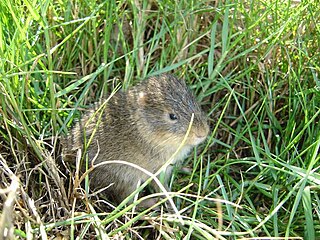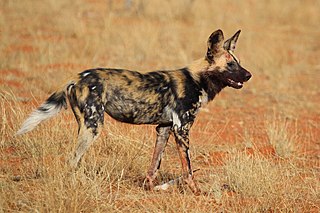
The chimpanzee, also known as the common chimpanzee, or simply chimp, is a species of great ape native to the forest and savannah of tropical Africa. It has four confirmed subspecies and a fifth proposed subspecies. The chimpanzee and the closely related bonobo are classified in the genus Pan. Evidence from fossils and DNA sequencing shows that Pan is a sister taxon to the human lineage and is humans' closest living relative.

A sawshark or saw shark is a member of a shark order bearing a unique long, saw-like rostrum edged with sharp teeth, which they use to slash and disable their prey. There are eight species within the Pristiophoriformes, including the longnose or common sawshark, shortnose sawshark, Japanese sawshark, Bahamas sawshark, sixgill sawshark, African dwarf sawshark, Lana's sawshark and the tropical sawshark.

The common degu, or, historically, the degu, is a small hystricomorpha rodent endemic to the Chilean matorral ecoregion of central Chile. The name degu on its own indicates either the entire genus Octodon or, more commonly, just the common degu. Common degus belong to the parvorder Caviomorpha of the infraorder Hystricognathi, along with the chinchilla and guinea pig. The word degu comes from the indigenous language of Chile, Mapudungun, and the word dewü, meaning 'mouse' or 'rat'.

Caviidae, the cavy family, is composed of rodents native to South America and includes the domestic guinea pig, wild cavies, and the largest living rodent, the capybara. They are found across South America in open areas from moist savanna to thorn forests or scrub desert. This family of rodents has fewer members than most other rodent families, with 19 species in 6 genera in 3 subfamilies.

The harp seal, also known as saddleback seal or Greenland seal, is a species of earless seal, or true seal, native to the northernmost Atlantic Ocean and Arctic Ocean. Originally in the genus Phoca with a number of other species, it was reclassified into the monotypic genus Pagophilus in 1844. In Greek, its scientific name translates to "ice-lover from Greenland," and its taxonomic synonym, Phoca groenlandica translates to "Greenlandic seal."

The brown fur seal, also known as the Cape fur seal, South African fur seal and Australian fur seal, is a species of fur seal.

The hairy-legged vampire bat is one of three extant species of vampire bats. It mainly feeds on the blood of wild birds, but can also feed both on domestic birds and humans. This vampire bat lives mainly in tropical and subtropical forestlands of South America, Central America, and southern Mexico. It is the sole member of the genus Diphylla.

Caviinae is a subfamily uniting all living members of the family Caviidae with the exception of the maras, capybaras, and Kerodon. The subfamily traditionally contained the guinea pig or cavy-like forms along with the cursorially adapted (running) Kerodon. Molecular results suggest the Caviinae as so defined would be paraphyletic and Kerodon is more closely related to maras and capybaras than to other caviines. This led Woods and Kilpatrick (2005) to unite Kerodon and capybaras into the subfamily Hydrochoerinae within the Caviidae. These studies also suggest Microcavia and Cavia are more closely related to one another than either is to Galea.

The rock cavy or mocó is a cavy species endemic to eastern Brazil, that has been introduced to the Atlantic island of Fernando de Noronha.

The Patagonian mara is a relatively large rodent in the mara genus Dolichotis. It is also known as the Patagonian cavy, Patagonian hare, or dillaby. This herbivorous, somewhat rabbit-like animal is found in open and semiopen habitats in Argentina, including large parts of Patagonia. A population has also been recorded in the northern United Arab Emirates, possibly as a result of escaped pets or captive animals. It is monogamous, but often breeds in warrens shared by several pairs.

Santa Catarina's guinea pig or Moleques do Sul cavy is a rare guinea pig species of southeastern South America.
The Brazilian yellow-toothed cavy is a cavy species from South America. It is found in Brazil.

Spix's yellow-toothed cavy is a rodent, a cavy species from South America. It is found in Bolivia east of the Andes and much of south central to northeastern Brazil. The species is found in open savanna and semiarid habitats, such as the Cerrado and Caatinga of Brazil. Its karyotype is 2n = 64 and FN = 118.
The common yellow-toothed cavy is a species of rodent in the family Caviidae, closely related to the domesticated guinea pig. It is found in Argentina, Bolivia, Chile, and Peru. It's karyotype has 2n = 68 and FN = 136. G. musteloides is the most common and widely found member of Galea, and is present at elevations ranging from 20 to 5000 m above sea level. It has yellow teeth.

The southern mountain cavy is a species of South American rodent in the family Caviidae.

Scotophilus is a genus of vespertilionid bats commonly called yellow bats. They are found in southern Asia and Africa. They are the only members of the tribe Scotophilini.

The African wild dog also called the African painted dog and the African hunting dog, is a wild canine which is a native species to sub-Saharan Africa. It is the largest wild canine in Africa, and the only extant member of the genus Lycaon, which is distinguished from Canis by dentition highly specialised for a hypercarnivorous diet, and by a lack of dewclaws. It is estimated that about 6,600 adults live in 39 subpopulations that are all threatened by habitat fragmentation, human persecution, and outbreaks of disease. As the largest subpopulation probably comprises fewer than 250 individuals, the African wild dog has been listed as endangered on the IUCN Red List since 1990.

Infanticide is the termination of a neonate after it has been born, and in zoology this is often the termination or consumption of newborn animals by either a parent or an unrelated adult. In rodents, it is not uncommon for the mother to commit infanticide shortly after parturition under conditions of extreme stress, or for an unrelated male to kill neonates.

Galea is a genus of South American rodents of the family Caviidae. Five extant species are known, found in Argentina, Bolivia, Chile, Peru and Brazil. They are:
Dr. Barbara J. Weir was a scientist, adventurer, and editor from the United Kingdom. Her discovery and extensive study of estrus in Galea musteloides illuminated the workings of some rodents' reproductive systems. Her discovery and extensive study of estrus in Galea musteloides illuminated the workings of some rodents' reproductive systems. Barbara Weir is most recognized for her comparative study on the breeding habits of Cavia aperea, and two related species, Galea musteloides, and Microcavia australis. Weir was also an editor for the Journal of Reproduction and Fertility from 1976-1990 where she was recognized for her “firm and fair role” as editor.

















